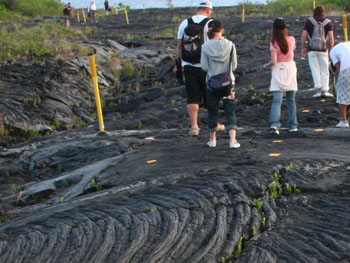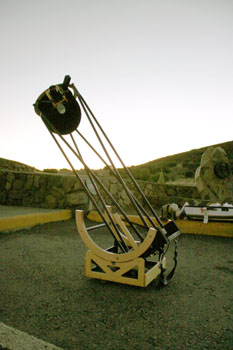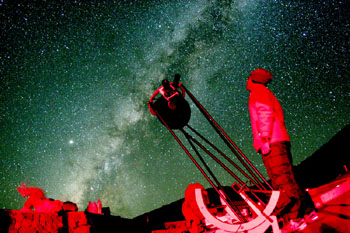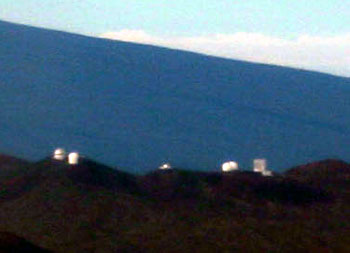Trip to Hawaii Sep 2008
The place where the Earth and the Cosmos contact
I went on a trip to the Big Island (Hawaii Island) with my friend for
star watching and lava viewing. One of the destinations was the Onizuka
Center for International Astronomy Visitor Information Station on
Mauna
Kea, an altitude of 2800 m, and another was the lava viewing point,
near Kalapana, the southeast coast.

Solid lava
In the evening Monday September 22, we arrived at the lava viewing
point 30 minutes before the sunset, but at that time we could see only
smoke that was produced by the reaction of lava and ocean water. During
the twilight the sky near the smoke sometimes turned red because of
eruption, and after dark the sky always looked red. The Island spread
the area by the flow of lava! It has created this Island, Mauna Kea,
and Mauna Loa, and Mauna Kea is one of the best observing sites of
universe in the world. This is the place where the Earth and the Cosmos
contact.
Eruption colored the sky
red
Eruption and Venus
We visited the Visitor Information Station on Sunday, Tuesday, and
Wednesday. The naked eye limiting magnitude was between 7.5 and 8.0.
This site was not necessarily ideal for star watching since many tour
buses and other vehicles stopped by, and the light disturbed
observation. After 9:30p.m. few cars went up or down and the situation
became much better. The merit of the Information Station is that there
is a restroom and a kiosk where hot drink is available and some people
to talk about astronomy. If you want to concentrate on observation, you
should go up a parking lot at an altitude of some 3500 m. This time we
did not rent 4WD car that is mandatory to pass the Station.
One of the nights, Sunday September 21, was cloudy, and windy; I could
not operate my 30 cm Dobsonian and the telescope field was unstable due
to strong wind. The circumstances got worse with time and it began to
rain around 9:30p.m! The other two nights, Tuesday and Wednesday, were
dry and stable with breeze.
 My 30 cm Dobsonian is ready to
observe in front of the Onizukafs relief.
My 30 cm Dobsonian is ready to
observe in front of the Onizukafs relief.
When I visited the Mauna Kea
last time seeing was superb; diffraction
ring was almost perfect. Though I thought it is a usual situation,
actually it is not. Diffraction ring did not look ring-like and tended
to deform this time. I expected excellent image of Jupiter, however, it
was not as expected because of moderate seeing (even so it was much
better than that of my town).
My 30 cm Dobsonian telescope that I carried with a suitcase worked very
well except Sunday (strong wind). The scope was equipped with the NGC
Max, digital setting circles. The eyepieces were EWV 32 mm (Kasai),
Ethos 13 mm, and Ethos 8 mm. I also used barlow lenses, 3x and 2x, and
filters, OIII and H-beta.

Awesome! Milky Way. Click to enlarge
Impression
Jupiter: Ganymedefs shadow was
casted on the disk of Jupiter at dusk September 23. With 563x I
recognized faint pattern on Iofs surface, but this magnification was so
high that the image of Jupiter was blurred yielding low contrast.
Magnification of less than 400 was effective.
M8: The outline looked the same
with that of photo without filter, i.e. even faint part of the nebula
could be observable. With an OIII filter the nebula stood out and
looked just like an astrophotography.
M17 and M20: As with M8 the
outline looked the same with the astrophotography. For M17 the tail of
the swan and for M20 a four-leaf clover was evident, respectively. With
the OIII filter faint part was highly intensified.
M51: Spiral structure was
apparent with direct vision, even when the galaxy was less than 20
degrees of altitude.
M57: Very bright. Central star
could not be detected with 375x and 563x, though the star is observable
with my 46 cm under excellent condition at usual observing site near my
house.
Veil nebula NGC6960:
Impressive! Even without filter veil-like structure was apparent and
bright. With the OIII filter it looked very bright. The appearance with
30 cm in Mauna Kea was almost the same with that of 46 cm at my usual
observing site.
Veil nebula NGC6992: The
situation was the same with NGC6960 but the detail was much clearer
with my 46 cm at the usual observing site near my house. NGC6974, 6979
and unnumbered super nova remnants between NGC6960 and NGC6992 were
easy without filter.
NGC253: Bright. Dark lane was
apparent.
NGC55: Large! Structure was
apparent.
M45: Nebula around Merope
extended nearly one degree southward. It was easy to see even at a low
altitude, i.e. some 20 degrees.
NGC1499 California nebula: Very
easy with H-beta filter and structure in the nebula was apparently
observable. I did not try without filter.
M22, M13, and other globular clusters:
Globular clusters were beautiful since the background was dark enough
and it made darker stars prominent. However, the clusters looked more
impressive with my 46 cm comet seeker near my town because of higher
light gathering power. Here in Mauna Kea, you can observe 1.5
magnitudes darker stars than in the low land, but this effect is
inferior to the light gathering power of the 46 cm primary mirror.
M33: Spiral structure was clear
with direct vision that made me vertiginous. Faint outer part of the
galaxy was evident. I have never observed such a large size of M33!
What I have learned from this trip:
Comparison of 30 cm at Mauna Kea (MK) and 46 cm at my usual observing
site (UOS)
Star like object: 30 cm at MK < 46 cm at UOS
Faint nebula: 30 cm at MK >> 46 cm at UOS
The above-mentioned implies that you can compensate light pollution
with larger amateur if you observe star-like objects but this cannot be
applied to faint objects. We need to conserve dark and transparent sky
that diminishes on this planet.

Hotel in Hilo

Top of the Mauna Kea viewed from our flight from Hilo to Honolulu
Background is Mauna Loa
Back to Top





 My 30 cm Dobsonian is ready to
observe in front of the Onizukafs relief.
My 30 cm Dobsonian is ready to
observe in front of the Onizukafs relief.

